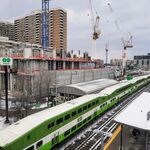Hipster Duck
Senior Member
You say Mississauga is too decentralized, so you solution solution is a transit system that concentrates on nodes??? Are you serious?
If you read my post, you would see that I think that Mississauga wants to intensify its existing (MCC) core, but has to deal with the fact that the overwhelming majority of its commuter trips are to decentralized locations. That's why I argue for a system like regional rail that travels quickly and carries a lot of people from node to node in a vast region, while connecting trips to the decentralized hinterland are made by a flexible bus solution.
A decentralized or dispersed urban form requires a grid-like transit system, not a radial system. You can't have a radial system without a very strong core, which Mississauga does not have. That's why LRT lines along Dundas and Hurontario are best solution for Mississauga.
Again, Mississauga's intention is to concentrate office and residential development in the core (its success - particularly on the office front - is another story). I'm not sure how many people would use intermediate stops on an LRT between MCC and Islington/Kipling; and if they did, would their trip ultimately be faster if it was on a bus to a frequent regional rail (REX) station?
Also, I don't think that having one or two LRT lines constitues a "grid".




